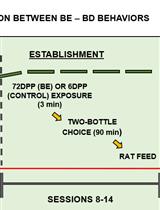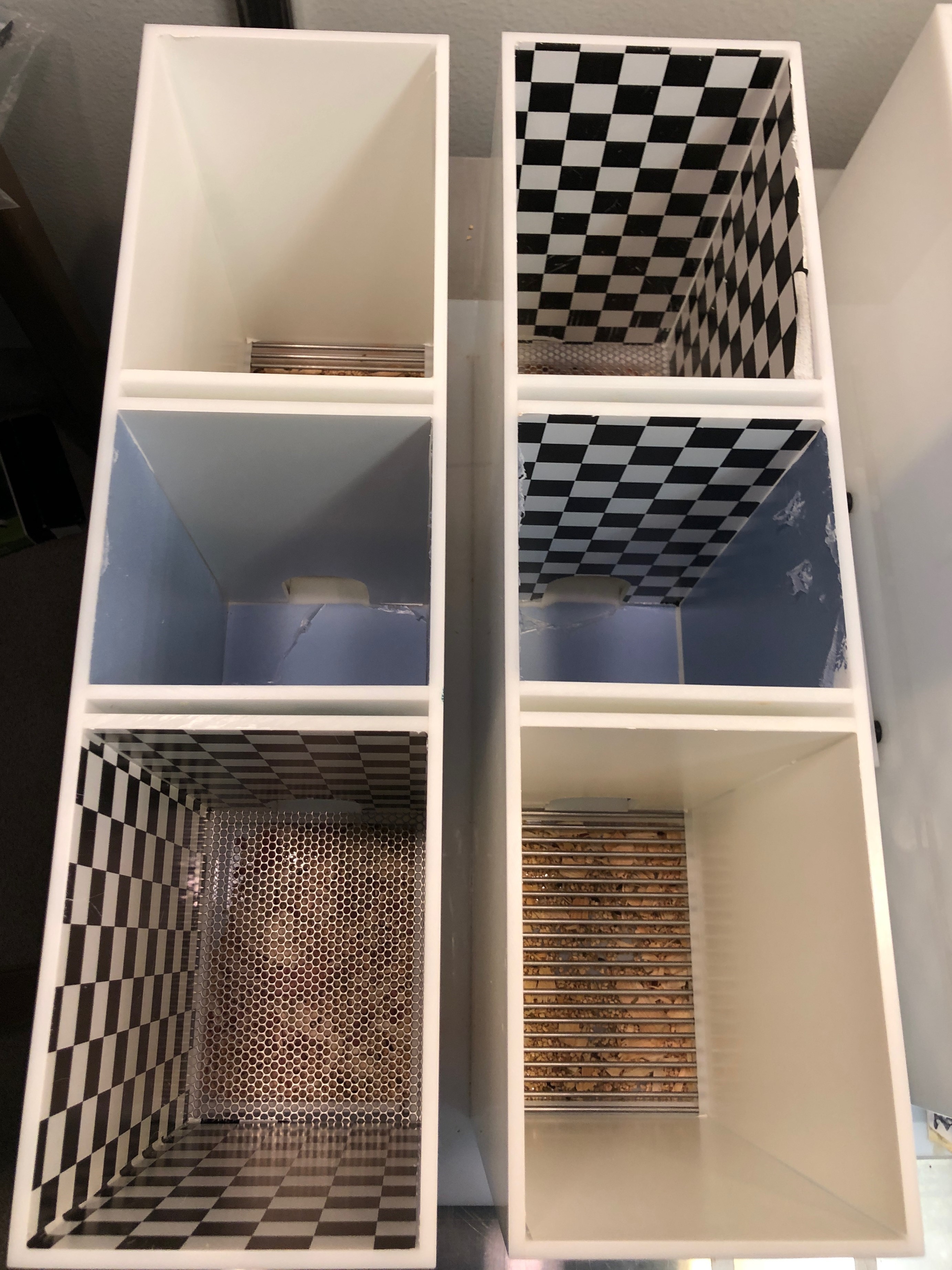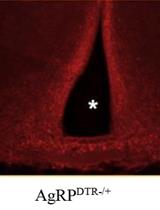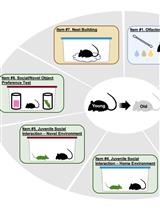- EN - English
- CN - 中文
Examining Cocaine Conditioning Place Preference in Mice
可卡因调节小鼠位置偏爱研究
发布: 2020年04月20日第10卷第8期 DOI: 10.21769/BioProtoc.3595 浏览次数: 5415
评审: Soyun KimAlexandra GrosAnonymous reviewer(s)

相关实验方案

从食物到酒精的狂饮:雄性Wistar大鼠嗜酒行为之间的顺序相互作用
Sergio Cuesta-Martínez [...] Cruz Miguel Cendán
2023年08月05日 1321 阅读
Abstract
A key component of combating substance use disorders is understanding the neural mechanisms that support drug reward. Tasks such as self-administration assess the reinforcing properties of a drug using a learned behavior but require numerous training sessions and surgery. In comparison, the conditioned place preference (CPP) task assesses reward with little training, without costly surgeries, and confounds that accompany the use of anesthesia or pain-relieving drugs. The CPP task contains three phases: pretest, conditioning, and posttest. During the pretest, mice are allowed to explore a three-compartment apparatus. The two outer compartments contain unique olfactory, tactile, and visual cues whereas the middle compartment is used as an entrance and exit for the mice on test days. During conditioning, mice receive cocaine before being confined to one of the outer compartments. The following day, mice are given saline then confined to the other outer compartment. These pairings are then repeated once. At posttest, mice are permitted to freely explore all compartments in a drug-free state while the time spent in each compartment is recorded. A CPP score is calculated for both the pretest and posttest by comparing the time spent in the cocaine-paired and saline-paired compartments. Enhancements in the CPP score from the pretest to the posttest serve as a measure of the rewarding property of the cocaine. This task offers several notable advantages: 1) the simultaneous recording of locomotor activity and reward, which may utilize different neural mechanisms, 2) the three-compartment CPP setup removes the bias that can be observed in a two-compartment design, and 3) use of multimodal cues support the acquisition of a robust preference in a variety of mouse strains.
Background
The conditioned place preference (CPP) paradigm has been used for decades to examine the role of genes, histone modifications, signaling pathways, and brain regions in drug-associated memory and reward (see Tzschentke, 1998; Malvaez et al., 2009). It incorporates classical conditioning to assess the rewarding effects of contextual cues that have been associated with a drug (for reviews see Schechter and Calcagnetti, 1993; Everitt et al., 1999; Bardo and Bevin, 2000). There are various CPP chamber designs and configurations, depending on the specific research question being addressed (Bardo and Bevin, 2000). However, the most commonly used designs are the two-compartment or three-compartment chambers. Both chambers types rely on the ability of mice to differentiate between two compartments that contain distinct olfactory, tactile, and visual cues. The three-compartment design contains an additional compartment, between the two larger compartments, that does not contain olfactory or tactile cues, and is used only for the entry and removal of mice at test. Here, we describe the equipment setup, key parameters, and data collection in the three-compartment CPP paradigm using adult mice. The focus of this protocol is on cocaine CPP. However, this paradigm can be used for other drugs of abuse (e.g., other psychostimulants, opioids, and nicotine).
The three-compartment design allows mice to choose whether to enter either the cocaine or saline-paired compartments or remain in the center compartment. Conversely, the two-compartment chambers require mice to be placed in either the saline-paired or the cocaine-paired compartments to begin the test. This has the potential to introduce bias for the compartment in which the mice is place at post-test. Using tactile, olfactory and visual cues allows mice to form a memory for each context that does not rely on one sensory system. Therefore, the likelihood that mice with sensory deficits (e.g., poor vision) will fail to acquire a drug-associated preference is reduced. Other variations of the task (e.g., olfactory only) can require four cocaine pairings, which results in eight total injections when the saline injections are included. Acquisition in our task requires two cocaine pairings (four total injections) for robust cocaine CPP, which reduces the likelihood that stress and irritation at the site of injection will be significant factors in the experiment. Furthermore, if both the control and experimental groups equally acquire a preference, the posttest day of the CPP task can serve as the first day of an extinction experiment. This subsequent extinction experiment would allow the experimenter to examine the persistence of the acquired cocaine-associated memory. Overall, the CPP paradigm provides an adaptable, quick, and inexpensive method of assessing drug reward in adult mice.
Materials and Reagents
- Paper towels
- BD 1 ml Syringe slip tip with BD PrecisionGuideTM needle, 26G x 5/8 (0.45 mm x 16 mm; Fisher Scientific, catalog number: BD 309597 )
- Gloves (to be worn at all times that researchers will come into contact with mice)
- Handling sleeve (Ansell, catalog number: 19-120-3177 )
- Bedding: Pine shaving (P.J. Murphy Forest Products)
- Cedar bedding (PetsPick)
- Mice (8-15 weeks old) of either sex are housed individually beginning a week prior to behavioral testing
Mice have free access to food and water in their homecage. Environmental enrichment such as nesting materials (e.g., nestlets) and a retreat are features of each homecage. Their homecage area is temperature-controlled (23 °C) with a 12:12 h. light/dark cycle. Behavioral testing is performed during the light portion of the cycle.
Note: This protocol has been optimized using C57BL/6J mice but can be used for other strains as well. - 70% (v/v) ethanol diluted from stock using water (Fisher Scientific, catalog number: A4094 )
- Sterile saline (Growcells, catalog number: msdw-1000 , Shelf life: 3 years, stored at room temperature)
- Cocaine hydrochloride (Sigma-Aldrich, CAS number: 53-21-4)
Equipment
- Heavy-Duty Utility Cart (RubbermadeTM, catalog number: 11-926-75 )
- CPP chambers (custom-made; Figure 1)
- Four digital cameras mounted above the CPP chambers (e.g., monochrome IR GigE camera set; Noldus Information Technology)
- Overhead camera-mounting bracket
- Overhead lamps
- Stopwatch with a silent mode
- Lux meter (Fisher Scientific, catalog number: 0 666264 )
- Dell Precision desktop (e.g., Processing Unit Precision T5810)

Figure 1. Two conditioned place preference apparatus. The outer compartments (Floor: 12.5 cm x 17 cm; Height: 32.5 cm) are separated by a smaller inner compartment (Floor: 12.5 cm x 11.5 cm; Height: 32.5 cm). The compartment with checkered contact paper has a grid floor with cedar shaving below. The compartment with white contact paper has bar flooring with pine chips below. The middle compartment has a solid gray floor, two gray walls, and two walls with either checkered or white contact paper to match the adjoining outer compartments. Guillotine doors separate the outer compartments from the middle compartment.
Software
- EthoVision XT tracking system (Noldus Information Technology, Inc. Leesburg, Virginia)
- Microsoft Excel (Microsoft)
- Statistical Software (i.e., SPSS, GraphPad Prism, R)
Procedure
文章信息
版权信息
© 2020 The Authors; exclusive licensee Bio-protocol LLC.
如何引用
Simkevich, M. J., Campbell, R. R. and White, A. O. (2020). Examining Cocaine Conditioning Place Preference in Mice. Bio-protocol 10(8): e3595. DOI: 10.21769/BioProtoc.3595.
分类
神经科学 > 行为神经科学 > 实验动物模型
神经科学 > 神经解剖学和神经环路 > 动物模型
您对这篇实验方法有问题吗?
在此处发布您的问题,我们将邀请本文作者来回答。同时,我们会将您的问题发布到Bio-protocol Exchange,以便寻求社区成员的帮助。
Share
Bluesky
X
Copy link










